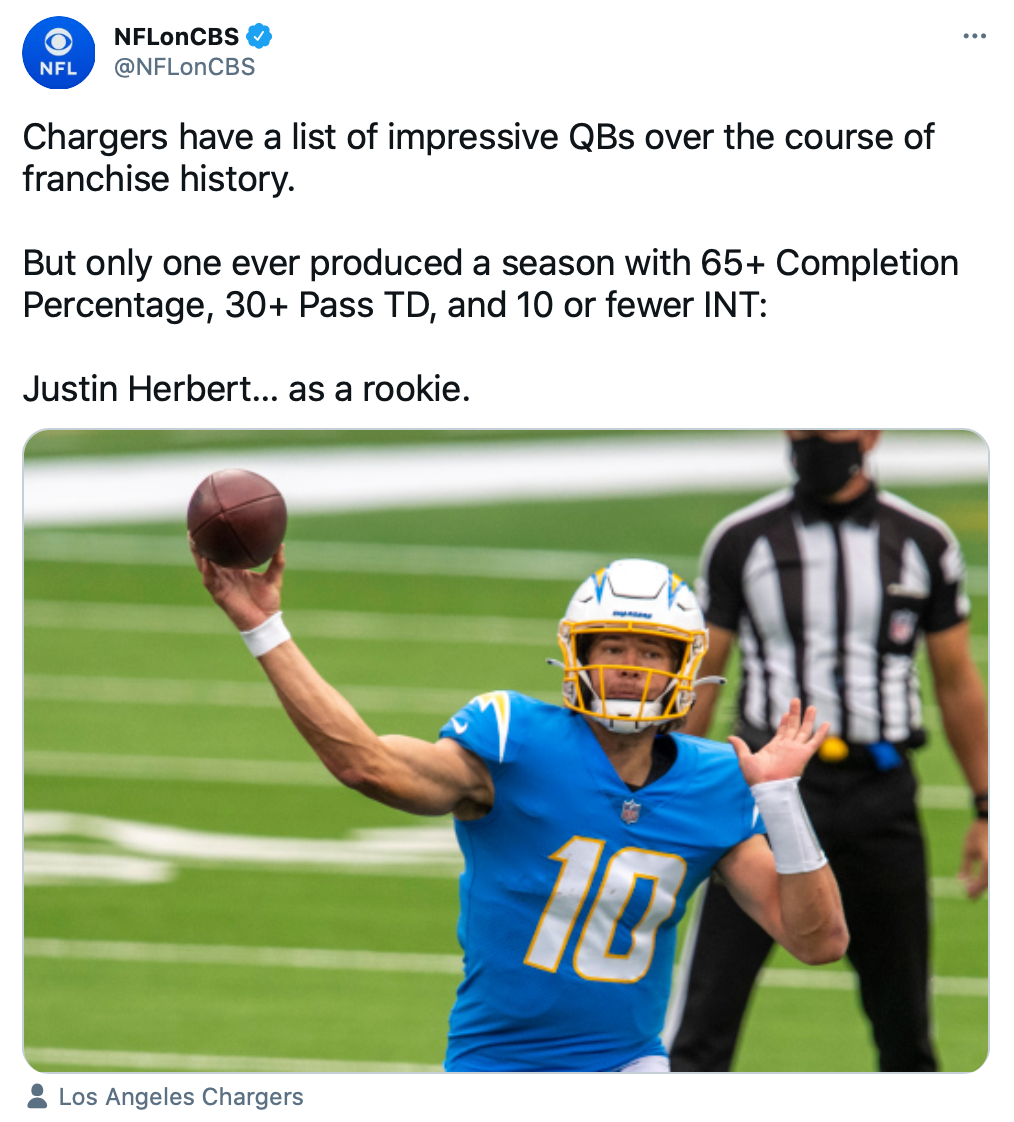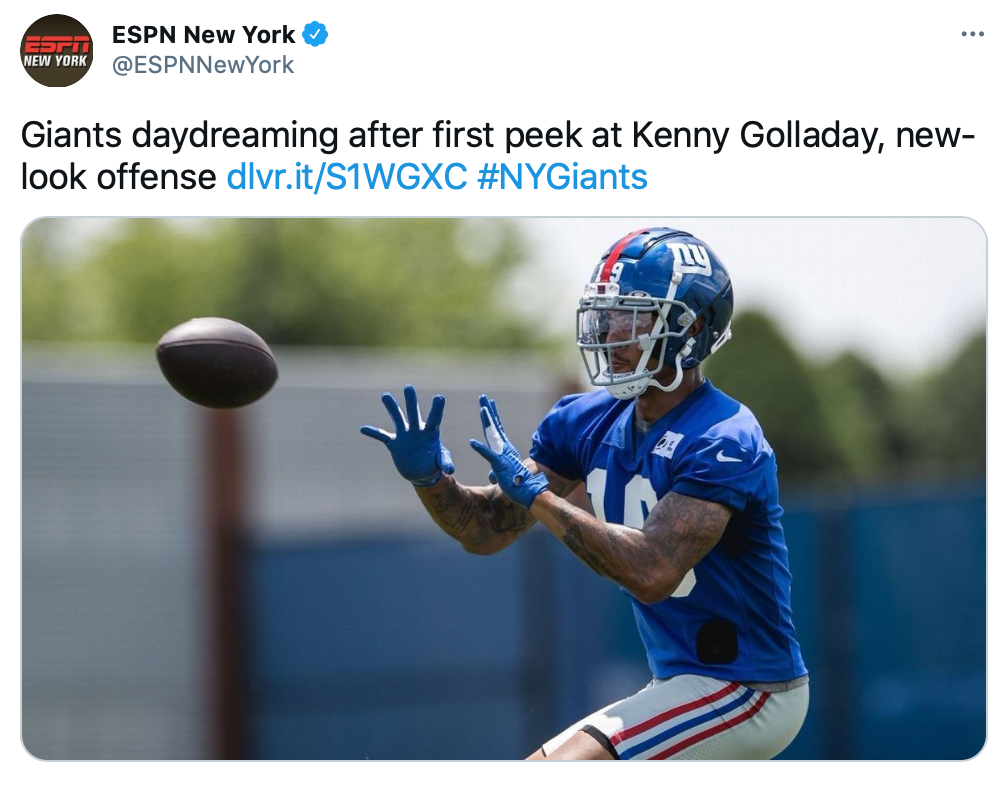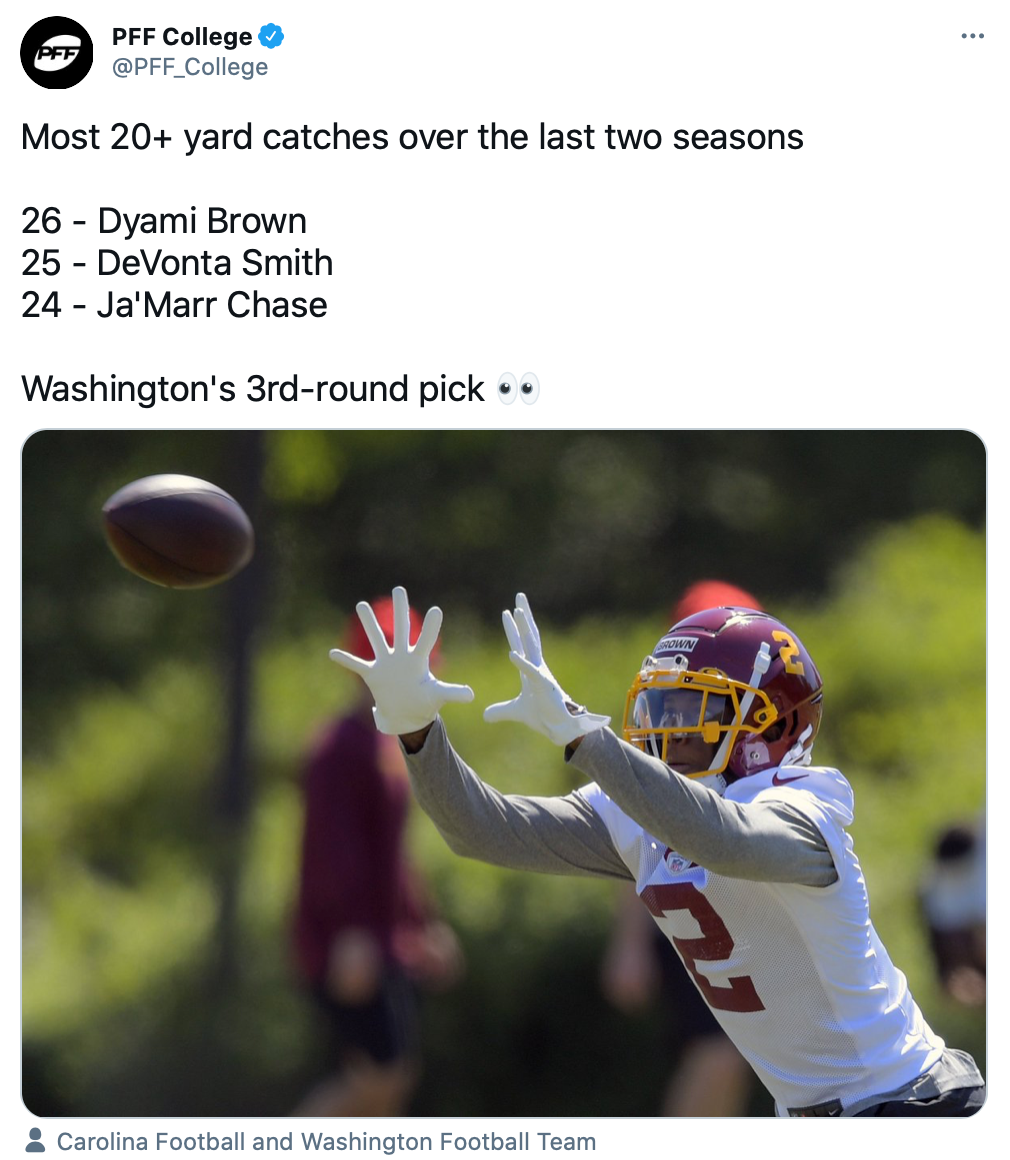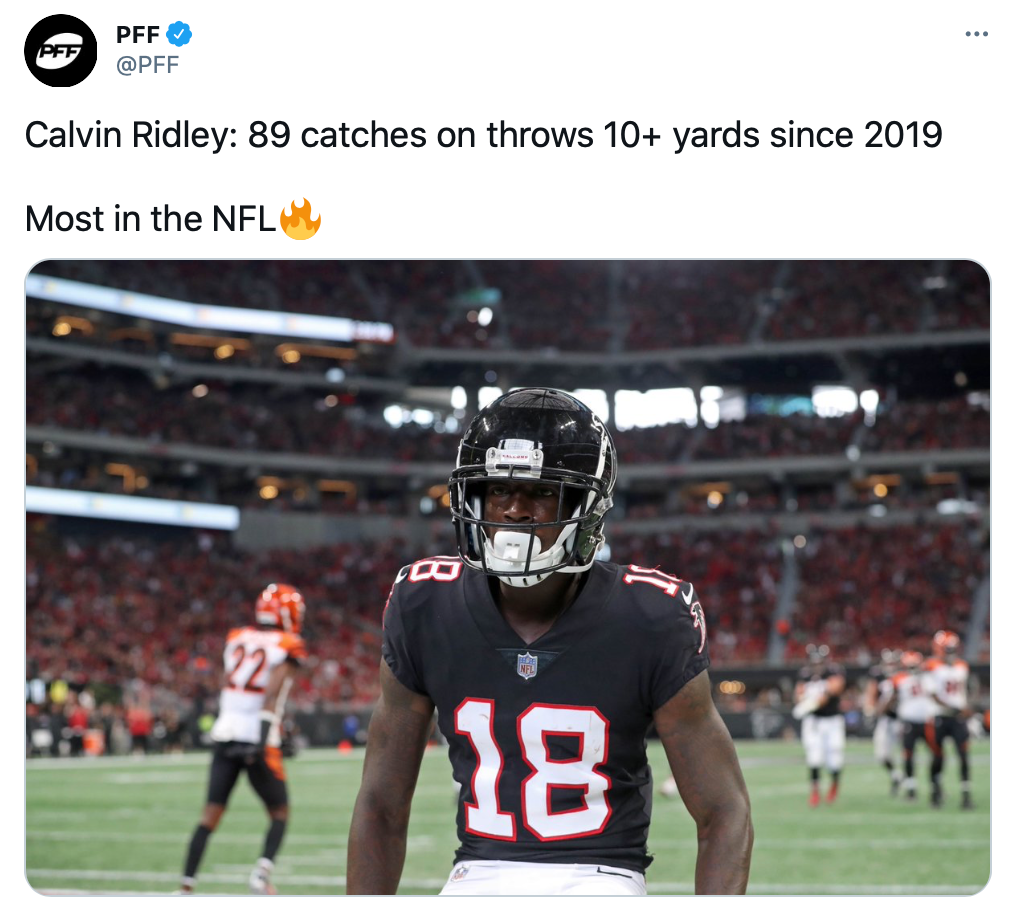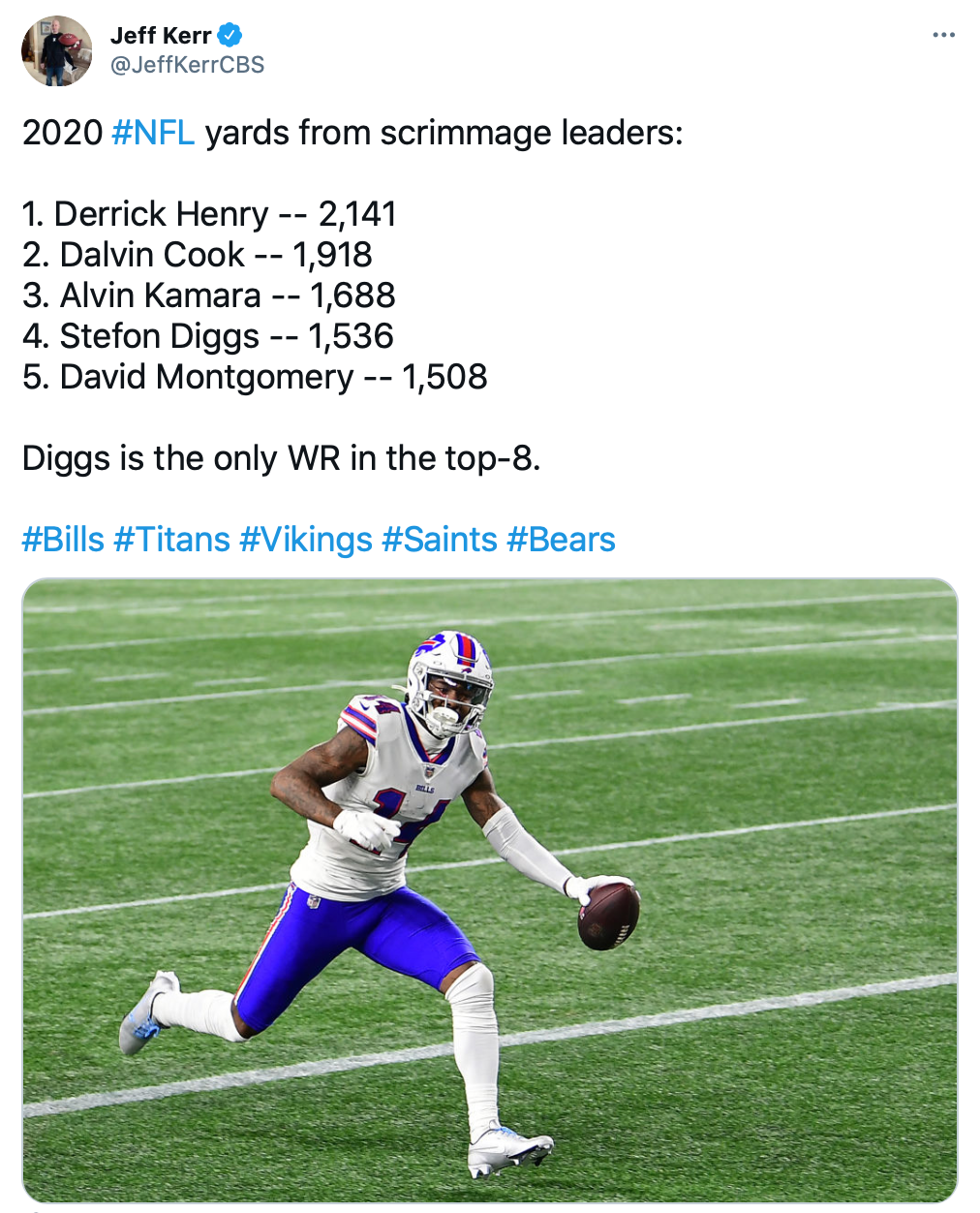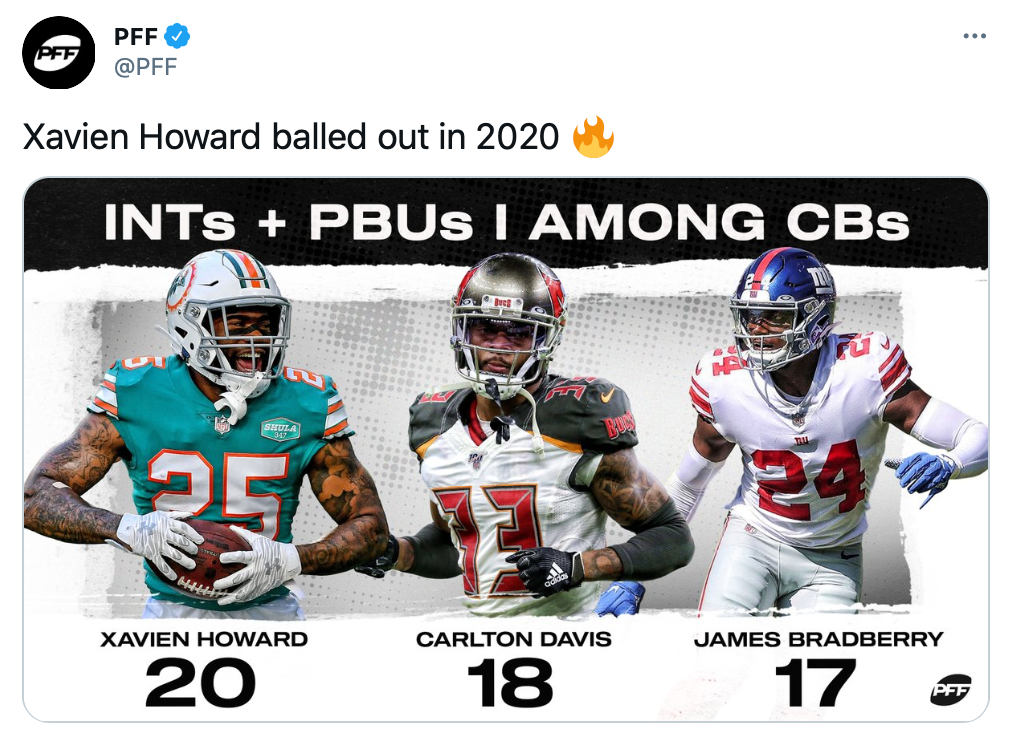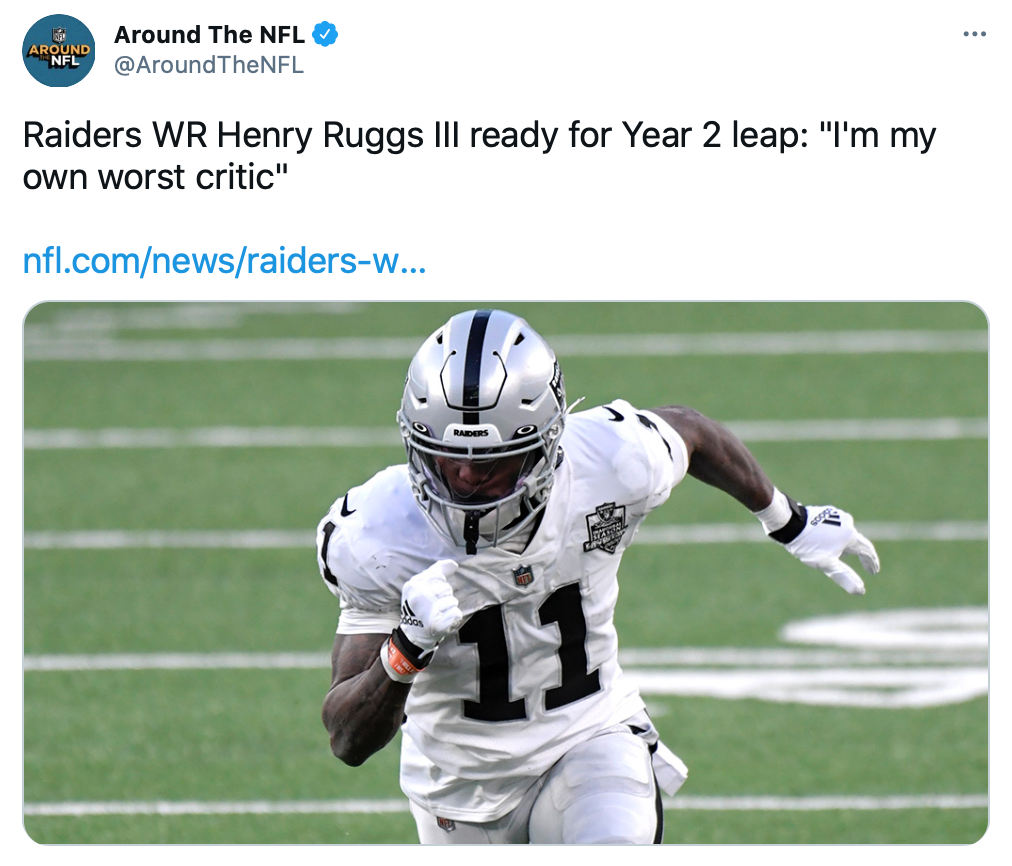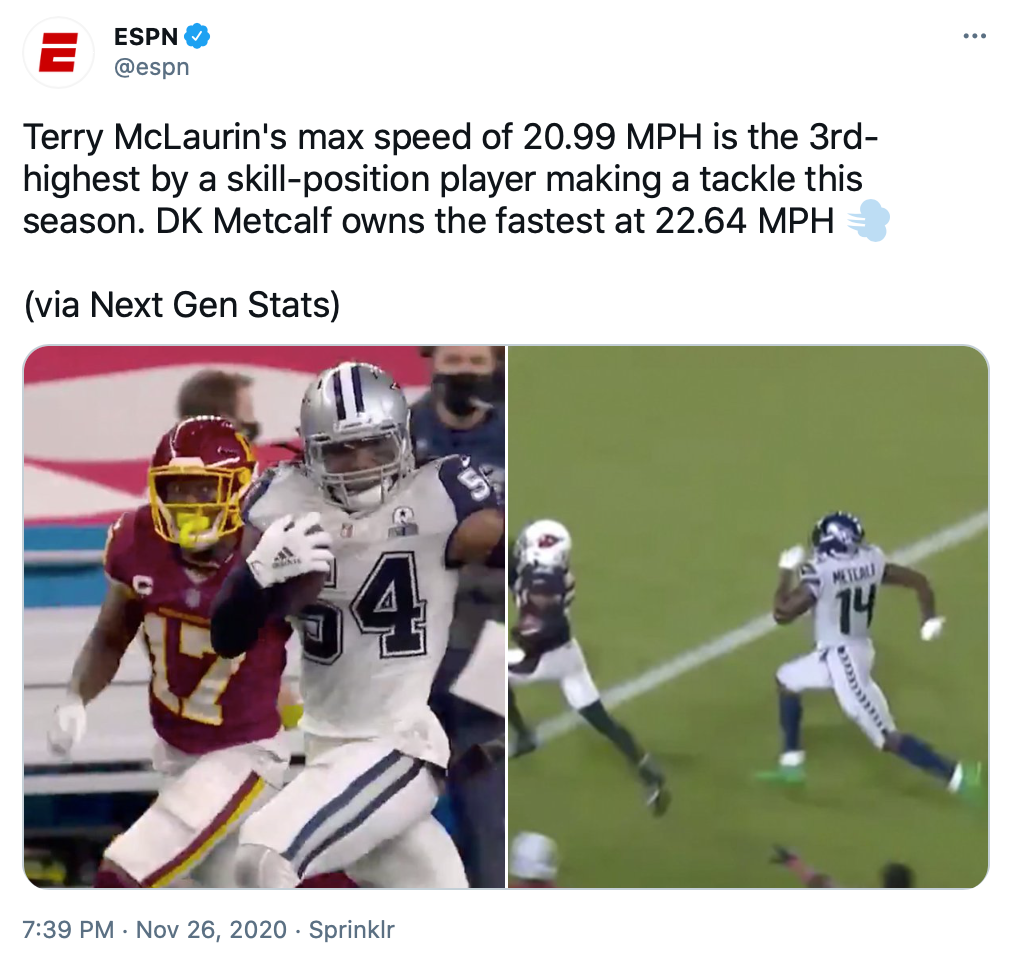Early every NFL in-season Tuesday morning, our grind begins with a collection of the previous week’s statistics. Even if your spreadsheets are perfectly constructed, only requiring a plug-in of the numbers, the process can take a full day to complete. That stretch of time is easily duplicated for those, like me, who operate within the world of college football.
Guess what? It’s Thursday morning, the first NFL matchup of the new week is merely hours away, and we’ve yet to even begin evaluating the matchups. Since we have every intention of getting our entries constructed, submitted into each of the early offerings from our favorite DFS platforms, there simply must be steps we can take early on to jump ahead of the curve. Lucky enough for us, we can take several steps during the offseason to reduce the amount of prepwork to complete on those hectic Thursdays.
Short of direct plug-and-play of the numbers from our data providers, there’s nothing we can do about the statistical collection process. But I actually value that process. It’s an opportunity for me to catch many of the performances I’ve unintentionally overlooked from the previous week. However, since we have already been provided with the entire 18-week NFL schedule, nothing stands in our way from taking a deep dive into the individual coverage matchups. Not to be confused with a general strength of schedule review, this series will identify the individual passing game contributors facing either the most explosive or least appealing matchups throughout the season. If your desire is a big-picture review of schedule strength, you will find an outstanding, thorough breakdown of each position based upon determined strength of schedule provided by Scott Barrett inside the following links: QB | RB | WR | TE.
The Basic Approach
The first order of business is accounting for the defensive coordinator (DC) turnover. A massive 44% of the DCs from last season have been replaced. Seven (22%) were forced out, four (13%) were lured to positions on new teams, and three (9%) voluntarily resigned or retired. For those teams hiring new DCs, we will need to wait until the first few weeks of the season have been played before we can draw a concrete understanding of their expected schemes. However, as the old saying goes: the tiger cannot change his stripes. Each of these newly hired DCs provide us with a paper trail of previous usage. Either as a position coach or coordinator, these newly installed DCs have already provided us with the framework we need for the purpose of tentatively evaluating the matchups. The first step, pulling from the defensive scheme history from every DC, involved collecting the three most-used coverage shells.
With a total of 272 games on the 2021 schedule, the 544 combined matchups for each team’s anticipated starting QB, WR1, WR2, WR3, and TE would be analyzed. That’s a grand total of 2,720 matchups. The next step involved recording the three coverage strengths, one weakness for each of those players. Whenever possible, each “strength” and “weakness” was determined based on the previous three seasons of play.
Therein lies an issue. We certainly do not want to exclude the players with less than three years of NFL play. For the rookies without a single game of action, the coverage strengths and weaknesses were pulled from college data. For the NFL sophomores, the data was drawn directly from those who submitted a complete/nearly complete season of data (i.e., Justin Herbert, Justin Jefferson, etc.). But the college numbers were again used for those failing to provide reliable data from their rookie seasons. Finally, for the few NFL veterans with, for whatever reason, limited action during the last three seasons (i.e., Tyrod Taylor, etc.), every attempt was made to fill in the blanks using information prior to the last three years.
The next step involved highlighting the player matchups on both ends of the spectrum. The most exceptional of matchups received a green highlight in each of his three coverage strengths. The preliminary matchups to avoid would be facing a defense featuring their coverage scheme weakness without a single shell of strength. However, for each of the receivers evaluated, another step was required. The tiny detail of shadow threats would need to be factored. A receiver may be facing all three of his coverage scheme strengths, but drawing a coverage trail from a defender such as Jalen Ramsey or Bradley Roby would entirely squash those expectations.
For in-depth information on each of the most important defensive coverage schemes, make sure you check out the following links: Coverage Glossary | Cover 1 | Cover 2 | Cover 3 | Cover 4. If you missed the first entry in the series, here is the link where you can find the Advanced Matchup Preview of the QBs.
The “Perfect” WR1 Matchups
Determining who should be considered each team’s WR1 requires a certain amount of subjectiveness. Since I’ll be writing up separate entries for WR1s, WR2s, and WR3s, more than enough WRs will have their coverage schedules evaluated to offset any difference of opinion in the WR pecking orders. As for the “perfect” label, we’re looking for the matchups where a defense will feature each of the three determined strengths from a WRs history:
| Week | Team | Receiver 1 | Opponent |
| 1 | L.A. Chargers | Keenan Allen | Washington |
| 2 | L.A. Chargers | Keenan Allen | Dallas |
| 2 | N.Y. Giants | Kenny Golladay | Washington |
| 2 | Carolina | D.J. Moore | New Orleans |
| 3 | Buffalo | Stefon Diggs | Washington |
| 3 | Detroit | Breshad Perriman | Baltimore |
| 3 | Philadelphia | Jalen Reagor | Dallas |
| 3 | Washington | Terry McLaurin | Buffalo |
| 3 | New England | Nelson Agholor | New Orleans |
| 5 | N.Y. Giants | Kenny Golladay | Dallas |
| 5 | Tampa Bay | Mike Evans | Miami |
| 6 | New England | Nelson Agholor | Dallas |
| 6 | Tennessee | A.J. Brown | Buffalo |
| 7 | Arizona | DeAndre Hopkins | Houston |
| 8 | Denver | Courtland Sutton | Washington |
| 9 | Denver | Courtland Sutton | Dallas |
| 9 | Jacksonville | D.J. Chalk | Buffalo |
| 10 | New Orleans | Michael Thomas | Tennessee |
| 11 | Jacksonville | D.J. Chalk | San Francisco |
| 12 | Seattle | DK Metcalf | Washington |
| 13 | New England | Nelson Agholor | Buffalo |
| 14 | Washington | Terry McLaurin | Dallas |
| 15 | N.Y. Giants | Kenny Golladay | Dallas |
| 15 | Philadelphia | Jalen Reagor | Washington |
| 16 | New England | Nelson Agholor | Buffalo |
| 16 | Washington | Terry McLaurin | Dallas |
| 17 | Carolina | D.J. Moore | New Orleans |
| 17 | Philadelphia | Jalen Reagor | Washington |
| 18 | N.Y. Giants | Kenny Golladay | Washington |
| 18 | Philadelphia | Jalen Reagor | Dallas |
We do see A.J. Brown, DeAndre Hopkins, DK Metcalf, Keenan Allen, Michael Thomas, and Stefon Diggs, but some interesting names emerge from those benefiting from the scheduling. Keep in mind, the elite WRs only need a handful of routes across from a certain coverage and/or defender to submit a weekly top-10 outing. That’s what separates them from the rest of the WR field.
Kenny Golladay may not be widely considered as an elite WR but, should he manage to submit a fully healthy 2021 season, that narrative will be flipped on its head. Not only should Golladay’s name be considered within the top-10 NFL WRs, his signing within the NFC East will net him a pair of matchups from both Dallas and Washington. The Football Team’s defense was more than a match for opposing WRs last season and added William Jackson III. In addition to making some solid additions to their defense, Trevon Diggs greatly improved his play for the Cowboys over the final seven games of his rookie season, so much so that Diggs could quickly emerge as a shadow threat. But Golladay has been money in the bank over his career vs. each of the coverage schemes WFT DC Jack Del Rio and Dallas’ new DC Dan Quinn will deploy. That includes the eighth-highest fantasy points/route (FP/Rt, 0.51) and 11th-highest yards per route (YPRR, 2.65) over the last three seasons when facing Cover 4.
It sure does sound as though Jakobi Meyers is quickly emerging as Cam Newton’s go-to receiver. However, we actually need to see Nelson Agholor’s role in the offense before we can draw too many reliable conclusions. Judging from the matchups, Agholor equals Golladay for the most impeccable dates on the ‘21 schedule. After some disappointing seasons in Philadelphia, Agholor enjoyed a bit of a breakout with the Raiders. That included shredding Cover 3 (2.73 YPRR), Cover 4 (2.77), and Cover 1 (2.60). He accounted for 75% of his eight TDs facing those schemes that the Saints, Cowboys, and Bills will happen to feature.
For Jalen Reagor, a surgery to repair a tear in the UCL of his right thumb that occurred in Week 2 prevented him from taking the field again until Week 8. A 31/396/1 receiving line falls shy of offering reliable coverage shell production. As such, his profile for this purpose required a bit of digging into his college analytics. We do need to be careful when drawing conclusions based on pre-professional production. And we’ll need to see more working with Jalen Hurts to determine their connection. To really complicate matters, the Eagles drafted DeVonta Smith in the first round. I’m not completely sold on Smith producing immediate results in the NFL. It would really be disappointing to see new OC Shane Steichen — who made some statements alluding to the possibility — attempt to limit the rushing potential of Hurts. It was the ability of Hurts to evade pressure that set him apart from Carson Wentz. All told, we have more than a fair share of “ifs” on Reagor, so we need to be careful here.
He’ll have a new QB leading the attack — most definitely a good thing — but Terry McLaurin’s name is one that piques my interest in all formats. “F1 McLaurin” entered Week 13 at Pittsburgh as one of the top-10 WR performers last season. Doing so with lackluster QB play only adds to the impression. McLaurin then played through his final five games of the season with two high-ankle sprains. For all of his faults, Ryan Fitzpatrick is definitely not afraid to air it out. And McLaurin will have Curtis Samual and Dyami Brown helping to draw that safety attention away. Matchups with Buffalo and two with Dallas are, at the very least, must-start games in DFS. If you manage to roster “Scary Terry” in season-long formats, you should think long and hard before ever taking him out of your starting lineup.
Additional Prime WR1 Matchups of Note
The next data set is filled with the guys you certainly don’t need some analyst to tell you to play weekly in season-long formats. These matchups are of particular note to me since they pit the WR1s who excel vs. Cover 1 (man) and the defenses who feature a Cover 1 as its primary scheme. Consider this a DFS must-start list:
| Week | Team | Receiver | Opponent |
| 1 | Arizona | DeAndre Hopkins | Tennessee |
| 1 | Minnesota | Justin Jefferson | Cincinnati |
| 1 | Tennessee | A.J. Brown | Arizona |
| 2 | Buffalo | Stefon Diggs | Miami |
| 2 | Kansas City | Tyreek Hill | Baltimore |
| 2 | Minnesota | Justin Jefferson | Arizona |
| 3 | Arizona | DeAndre Hopkins | Jacksonville |
| 3 | New Orleans | Michael Thomas | New England |
| 4 | Cincinnati | Ja'Marr Chase | Jacksonville |
| 4 | Tennessee | A.J. Brown | N.Y. Jets |
| 5 | Atlanta | Calvin Ridley | N.Y. Jets |
| 5 | Green Bay | Davante Adams | Cincinnati |
| 5 | Tennessee | A.J. Brown | Jacksonville |
| 6 | Buffalo | Stefon Diggs | Tennessee |
| 6 | Dallas | Amari Cooper | New England |
| 7 | Atlanta | Calvin Ridley | Miami |
| 7 | Cincinnati | Ja'Marr Chase | Baltimore |
| 7 | Kansas City | Tyreek Hill | Tennessee |
| 8 | Buffalo | Stefon Diggs | Miami |
| 8 | Cincinnati | Ja'Marr Chase | N.Y. Jets |
| 8 | Green Bay | Davante Adams | Arizona |
| 9 | Buffalo | Stefon Diggs | Jacksonville |
| 9 | Minnesota | Justin Jefferson | Baltimore |
| 10 | Buffalo | Stefon Diggs | N.Y. Jets |
| 11 | Atlanta | Calvin Ridley | New England |
| 12 | Atlanta | Calvin Ridley | Jacksonville |
| 12 | Tennessee | A.J. Brown | New England |
| 13 | Buffalo | Stefon Diggs | New England |
| 14 | New Orleans | Michael Thomas | N.Y. Jets |
| 14 | Tennessee | A.J. Brown | Jacksonville |
| 15 | Green Bay | Davante Adams | Baltimore |
| 16 | Buffalo | Stefon Diggs | New England |
| 16 | Cincinnati | Ja'Marr Chase | Baltimore |
| 16 | New Orleans | Michael Thomas | Miami |
| 17 | Dallas | Amari Cooper | Arizona |
| 17 | Kansas City | Tyreek Hill | Cincinnati |
| 17 | Tennessee | A.J. Brown | Miami |
| 18 | Buffalo | Stefon Diggs | N.Y. Jets |
Working down alphabetically, make sure you do not discount A.J. Brown based on the notion that the addition of Julio Jones will reduce his production. Nobody should attempt to define the Titans as a pass-first offense. Derrick Henry will continue to be a workhorse for Tennessee. However, as we saw in their Wildcard loss to Baltimore last season, placing too much of an emphasis on the run turned one of the best offenses in the NFL stale. And their passing offense entirely stalled out during the second half of that game, and in Week 16 at Green Bay when Corey Davis was unavailable. The addition of Jones — health permitting — will not only keep opposing safeties honest, but he adds the elite presence against zone schemes to the man dominance from Brown. And Brown will not only face six teams featuring a primary Cover 1, four of his other defensive matchups will feature Cover 1 as its secondary coverage. Your math is right, that’s a total of 10 matchups where we want maximum exposure to Brown.
I’m actually quite a bit more excited for an even bigger second season from CeeDee Lamb now that he will be moved across the formation. That doesn’t mean we shouldn’t be all over Amari Cooper in Weeks 6 (New England — especially if Stephon Gilmore’s mini-holdout results in a change of scenery) and 17 (Arizona).
On the other end of the Julio trade, Calvin Ridley should be underlined multiple times by everyone. It’s true that, without Jones, the Atlanta passing attack proved to be quite handicapped. However, replacing Todd Gurley with Mike Davis and the drafting of Kyle Pitts will supply Matt Ryan with more than enough weapons to prevent defenses from focusing every available asset on stunting Ridley. When facing Cover 1 over the last three seasons, Ridley has put down 0.57 FP/Rt (12th-best), with a 52% jump in YPRR above his overall average.
Fantasy teams everywhere have their fingers crossed that Davante Adams will have Aaron Rodgers in tow this season. Adams is good enough to produce WR1-level numbers with either Jordan Love or Blake Bortles at QB, but his production will come nowhere close to that of 2020 without his partner in shine. It’s true that every bit of Ja’Marr Chase’s projection is drawn from his college play. However, we have more than his LSU numbers pushing us toward matchups opposed by Cover 1 defenses. We also have the fact that Joe Burrow is only a healthy season away from forcing his way into top-five QBs vs. Cover 1 conversation. It’ll take a bit of faith, but I’ll have plenty of DFS exposure to Chase in each of the four games on the list.
I’m hoping that if I bang the table enough times that people will get the hint on Justin Jefferson not only being a weekly no-brainer, but catapulted to the top of the DFS WR percent ownership whenever he’s facing a Cover 1-heavy matchup. Two factors are working against Michael Thomas:
- We don’t know who will replace Drew Brees between Jameis Winston and Taysom Hill.
- Continued concern over the bum ankle that cost him much of the ‘20 season.
Let’s be real here, it really won’t be a huge difference for “CantGuardMike” if he’s collecting targets from either Winston or Hill. Yes, they offer very different skillsets — including the coverages where they have the most success, but both offer Thomas and the offense QB1 traits. And why are we still discussing the ankle? Seems to me that it simply allows the industry something to write about. Even if Thomas’ ankle isn’t 100% — which I think it is — he will no doubt have found a suitable brace to keep him on the field. The Patriots, Jets, and Dolphins have solid secondaries, but it blows my mind how quickly some in the industry have soured on a guy that has powned NFL competition over his career. It’s that sound again: the knocking sound of OPPORTUNITY!
Your eyes are not deceiving you: Stefon Diggs will face off with defenses featuring Cover 1 in eight games this season. That number doesn’t even the four others opposed by a secondary Cover 1, or the three others from defenses featuring Cover 4 — Josh Allen’s personal specialty. On paper, no other receiver in the game benefits more from their schedules. I am of the mind that a very compelling case can be made for Diggs as the overall WR1 in redraft formats. That’s not to say he will avoid the elite shadows. A pair of matchups with both Xavien Howard and Gilmore definitely complicates those games. But Diggs is so good in one-on-one matchups that I will still have exposure, regardless of the shadow.
The next grouping is a truly rare breed: the WR1s who excel against Cover 2 and Cover 6 — the coverages that give offenses, on average, the most trouble:
| Week | Team | Receiver | Opponent | 1° Shadow Threat |
| 1 | Chicago | Allen Robinson | L.A. Rams | Jalen Ramsey |
| 2 | Cleveland | Odell Beckham | Houston | Bradley Roby |
| 3 | Cleveland | Odell Beckham | Chicago | Desmond Trufant |
| 4 | Baltimore | Marquise Brown | Denver | Kyle Fuller |
| 4 | Cleveland | Odell Beckham | Minnesota | Cameron Dantzler |
| 4 | Las Vegas | Henry Ruggs | L.A. Chargers | Chris Harris |
| 5 | Baltimore | Marquise Brown | Indianapolis | Xavier Rhodes |
| 5 | Cleveland | Odell Beckham | L.A. Chargers | Chris Harris |
| 5 | Las Vegas | Henry Ruggs | Chicago | Desmond Trufant |
| 6 | Baltimore | Marquise Brown | L.A. Chargers | Chris Harris |
| 6 | Chicago | Allen Robinson | Green Bay | Jaire Alexander |
| 6 | Las Vegas | Henry Ruggs | Denver | Kyle Fuller |
| 7 | Cleveland | Odell Beckham | Denver | Kyle Fuller |
| 7 | Las Vegas | Henry Ruggs | Philadelphia | Darius Slay |
| 9 | Baltimore | Marquise Brown | Minnesota | Cameron Dantzler |
| 9 | Las Vegas | Henry Ruggs | N.Y. Giants | James Bradberry |
| 11 | Baltimore | Marquise Brown | Chicago | Desmond Trufant |
| 14 | Chicago | Allen Robinson | Green Bay | Jaire Alexander |
| 15 | Baltimore | Marquise Brown | Green Bay | Jaire Alexander |
| 15 | Chicago | Allen Robinson | Minnesota | Cameron Dantzler |
| 16 | Cleveland | Odell Beckham | Green Bay | Jaire Alexander |
| 16 | Las Vegas | Henry Ruggs | Denver | Kyle Fuller |
| 17 | Chicago | Allen Robinson | N.Y. Giants | James Bradberry |
| 17 | Baltimore | Marquise Brown | L.A. Rams | Jalen Ramsey |
| 17 | Las Vegas | Henry Ruggs | Indianapolis | Xavier Rhodes |
| 18 | Chicago | Allen Robinson | Minnesota | Cameron Dantzler |
| 18 | Las Vegas | Henry Ruggs | L.A. Chargers | Chris Harris |
As you can see, I’ve also included the primary shadow threat tab. It’s also quite clear that many of these matchups for the WR1s offering these rare abilities avoid the elite shadow threats. And even the 33% who do avoid them will still be opposed by pretty damn good CBs (i.e., Xavier Rhodes and Kyle Fuller). For me, it’s quite simple. Even though these WR1s have accrued proof of their success for a reason, I avoid shadow matchups in DFS against Jalen Ramsey, Xavien Howard, Bradley Roby, Jaire Alexander, and James Bradberry without exception. Under those guidelines, the chart is reduced to the following:
| Week | Team | Receiver | Opponent | 1 Shadow Threat |
| 3 | Cleveland | Odell Beckham | Chicago | Desmond Trufant |
| 4 | Baltimore | Marquise Brown | Denver | Kyle Fuller |
| 4 | Cleveland | Odell Beckham | Minnesota | Cameron Dantzler |
| 4 | Las Vegas | Henry Ruggs | L.A. Chargers | Chris Harris |
| 5 | Baltimore | Marquise Brown | Indianapolis | Xavier Rhodes |
| 5 | Cleveland | Odell Beckham | L.A. Chargers | Chris Harris |
| 5 | Las Vegas | Henry Ruggs | Chicago | Desmond Trufant |
| 6 | Baltimore | Marquise Brown | L.A. Chargers | Chris Harris |
| 6 | Las Vegas | Henry Ruggs | Denver | Kyle Fuller |
| 7 | Cleveland | Odell Beckham | Denver | Kyle Fuller |
| 7 | Las Vegas | Henry Ruggs | Philadelphia | Darius Slay |
| 9 | Baltimore | Marquise Brown | Minnesota | Cameron Dantzler |
| 11 | Baltimore | Marquise Brown | Chicago | Desmond Trufant |
| 15 | Chicago | Allen Robinson | Minnesota | Cameron Dantzler |
| 16 | Las Vegas | Henry Ruggs | Denver | Kyle Fuller |
| 17 | Las Vegas | Henry Ruggs | Indianapolis | Xavier Rhodes |
| 18 | Chicago | Allen Robinson | Minnesota | Cameron Dantzler |
| 18 | Las Vegas | Henry Ruggs | L.A. Chargers | Chris Harris |
You still see the shadow threats that I view as elite bolded. However, I am not quite as quick to discount, and consider them on a case-by-case basis. For Allen Robinson, I am all in on him with either Andy Dalton or Justin Fields under center. Don’t take that as a discounting of Cameron Dantzler’s abilities, Robinson is simply one of the best in the business, especially against Cover 6. Over the last three years, “AR12” has generated 0.58 FP/Rt (ninth-best), and 3.21 YPRR (seventh-best) when facing a Cover 6.
The name on this list that has persuaded me to adjust in favor in season-long formats is Henry Ruggs III. First of all, with the Raiders stationed in the AFC West, he’ll have a pair of annual matchups waiting for him with the Broncos and Chargers. No, he didn’t set the world ablaze against them last season, but our approach is to trust in the process, not rookie struggles. In addition to the seven matchups above, Ruggs will also play eight defenses that gameplan a healthy amount of Cover 0 (all-out blitz). Both during his time at Alabama and in the NFL, Ruggs has collected enough production when teams throw everything but the kitchen sink that I can confidently refer to him as one of the best in the business. Much of that is directly related to his straight-line speed. Heaven help opposing defenses if the Raiders figure out the proper way to utilize Ruggs. I, for one, will be prepared for the day that they do.
Another WR1 on the list who struggled for much of last season is Marquise Brown. While some may worry that the addition of Rashad Bateman will somehow stall the output of “Hollywood,” I only see the addition as a positive. Let’s not forget that the current trend in the NFL — including the Ravens — is toward the benefits of the Air Raid. At its core, the Air Raid focuses its efforts toward providing each of its receivers with maximum space in order to discover the flaws in coverage. And it’s an approach that involves at least three WRs. With word coming down that Baltimore is determined to get J.K. Dobbins more involved in its passing game, adding him as another threat will only help both Brown and Bateman. If each significant skill remains healthy for the Ravens, that offense could be about to blow up.
Since most WR1s do very well against Cover 4 — the most vulnerable shell to the pass, our final data set will be those who excel vs. Cover 3, against the defenses featuring Cover 3:
| Week | Team | Receiver | Opponent | Shadow Threat 1 |
| 1 | Indianapolis | T.Y. Hilton | Seattle | Ahkello Witherspoon |
| 2 | Pittsburgh | Diontae Johnson | Las Vegas | Casey Hayward |
| 3 | Miami | DeVante Parker | Las Vegas | Casey Hayward |
| 6 | Pittsburgh | Diontae Johnson | Seattle | Ahkello Witherspoon |
| 6 | Seattle | DK Metcalf | Pittsburgh | Joe Haden |
| 8 | Jacksonville | D.J. Chalk | Seattle | Ahkello Witherspoon |
| 8 | Pittsburgh | Diontae Johnson | Cleveland | Denzel Ward |
| 9 | New England | Nelson Agholor | Carolina | Jaycee Horn |
| 10 | New England | Nelson Agholor | Cleveland | Denzel Ward |
| 11 | Washington | Terry McLaurin | Carolina | Jaycee Horn |
| 12 | Miami | DeVante Parker | Carolina | Jaycee Horn |
| 12 | Washington | Terry McLaurin | Seattle | Ahkello Witherspoon |
| 13 | Washington | Terry McLaurin | Las Vegas | Casey Hayward |
| 17 | Indianapolis | T.Y. Hilton | Las Vegas | Casey Hayward |
| 17 | Pittsburgh | Diontae Johnson | Cleveland | Denzel Ward |
Another WR1 who should benefit from his team’s additions, DeVante Parker has become somewhat of a forgotten man. I’m expecting Jaylen Waddle and Will Fuller V will provide Tua Tagovailoa with more than enough of the detached speed completely missing last season, guiding him to make a significant sophomore leap. Whatever helps Tagovailoa succeed will also benefit Parker and Mike Gesicki. The X-factor for the Dolphins’ offense will be its O-line.
Another WR1 who saw lackluster play at QB last season was Diontae Johnson. Should the full-health reports now multiple years removed from elbow surgery for Ben Roethlisberger prove true, DJ could be in line for even better results after his ‘20 breakout. Well, the scheduling should certainly provide a boost with four matchups against Cover 3-heavy teams. The remaining names on the list are supplied with additional positive matchups beyond those listed, but we do see further proof in favor of exposure to Nelson Agholor and especially Terry McLaurin.
The Avoid List
To reiterate the criteria for a weekly matchup to avoid, these are the WR1s facing a defense that not only includes their glaring coverage weakness and are void of featuring any of their scheme strengths. As with the matchups to target, this list is far from exhaustive. It simply highlights the matchups where we need to think long-and-hard in favor of avoiding:
| Week | Team | Receiver | Opponent | Shadow Threat 1 |
| 1 | Seattle | DK Metcalf | Indianapolis | Xavier Rhodes |
| 1 | Washington | Terry McLaurin | L.A. Chargers | Chris Harris |
| 2 | Jacksonville | D.J. Chalk | Denver | Kyle Fuller |
| 2 | San Francisco | Deebo Samuel | Philadelphia | Darius Slay |
| 3 | Tennessee | A.J. Brown | Indianapolis | Xavier Rhodes |
| 4 | Arizona | DeAndre Hopkins | L.A. Rams | Jalen Ramsey |
| 5 | Detroit | Breshad Perriman | Minnesota | Cameron Dantzler |
| 5 | Miami | DeVante Parker | Tampa Bay | Carlton Davis |
| 6 | Baltimore | Marquise Brown | L.A. Chargers | Chris Harris |
| 6 | Cleveland | Odell Beckham | Arizona | Malcolm Butler |
| 7 | San Francisco | Deebo Samuel | Indianapolis | Xavier Rhodes |
| 8 | Arizona | DeAndre Hopkins | Green Bay | Jaire Alexander |
| 8 | New England | Nelson Agholor | L.A. Chargers | Chris Harris |
| 8 | Tennessee | A.J. Brown | Indianapolis | Xavier Rhodes |
| 8 | Washington | Terry McLaurin | Denver | Kyle Fuller |
| 9 | Cleveland | Odell Beckham | Cincinnati | Chidobe Awuzie |
| 9 | L.A. Chargers | Keenan Allen | Philadelphia | Darius Slay |
| 9 | Philadelphia | Jalen Reagor | L.A. Chargers | Chris Harris |
| 10 | Denver | Courtland Sutton | Philadelphia | Darius Slay |
| 10 | Philadelphia | Jalen Reagor | Denver | Kyle Fuller |
| 11 | Buffalo | Stefon Diggs | Indianapolis | Xavier Rhodes |
| 11 | Cleveland | Odell Beckham | Detroit | Jeffrey Okudah |
| 11 | Dallas | Amari Cooper | Kansas City | Charvarius Ward |
| 11 | Las Vegas | Henry Ruggs | Cincinnati | Chidobe Awuzie |
| 12 | Denver | Courtland Sutton | L.A. Chargers | Chris Harris |
| 13 | Arizona | DeAndre Hopkins | Chicago | Desmond Trufant |
| 13 | Detroit | Breshad Perriman | Minnesota | Cameron Dantzler |
| 14 | Arizona | DeAndre Hopkins | L.A. Rams | Jalen Ramsey |
| 14 | Houston | Brandin Cooks | Seattle | Ahkello Witherspoon |
| 15 | Pittsburgh | Diontae Johnson | Tennessee | Janoris Jenkins |
| 15 | Washington | Terry McLaurin | Philadelphia | Darius Slay |
| 16 | N.Y. Giants | Kenny Golladay | Philadelphia | Darius Slay |
| 16 | Pittsburgh | Diontae Johnson | Kansas City | Charvarius Ward |
| 17 | Green Bay | Davante Adams | Minnesota | Cameron Dantzler |
| 17 | New York | Corey Davis | Tampa Bay | Carlton Davis |
| 17 | Washington | Terry McLaurin | Philadelphia | Darius Slay |
| 18 | Cleveland | Odell Beckham | Cincinnati | Chidobe Awuzie |
It’ll certainly be a painful decision to sit any one of these WR1s in season-long formats. And you’ll only consider doing so with a truly elite group of WR options. Some of the decisions will be made for you; each of the bolded shadows in combination with fielding each WR1’s coverage kryptonite will present a daunting challenge. For us DFS degenerates, that’ll be more than enough to straight avoid across the board. In season-long, chances are you’ll need to play the majority of these names, with your fingers crossed that they overcome their substantial history of failure.
Employing the Information
Don’t take this final explanation as me being lazy. It’s going to read nearly identical to the entry for the QBs. That’s due to all of the factors involved being nearly identical. First, everything depends on the format. As I’ve already stated, you want to start your studs in season-long formats unless you happen to have elite WRs on standby. By the conclusion of this series, you will already have a leg up in preparation over the massive DFS population.
Keep in mind, these WR1s have provided compelling data over a considerable stretch of action, and have either proven to have mastered or failed facing the specific coverage types. But why have these WR1s succeeded/failed? Three main factors help to answer that question:
- Pre-Snap Reads to Identify the Scheme
- When the QB and WR corps are able to identify the coverage, working together to employ the combo routes to attack all three levels of the secondary, and proven to succeed
- WR separation — when it comes to the world of receiving, the ability to get open is far more important than speed
Make no mistake, coverage schemes are not simply gimmicks. And, whether you like it or not, understanding how to take advantage of them in fantasy is a necessity. Coverages determine the scoring of every single *non-kicking) fantasy point scored in football. Teams either have a QB able to identify, attack, and the WRs able to get open or your offense falls flat on its face. Our fantasy squads mirror those alternatives.


